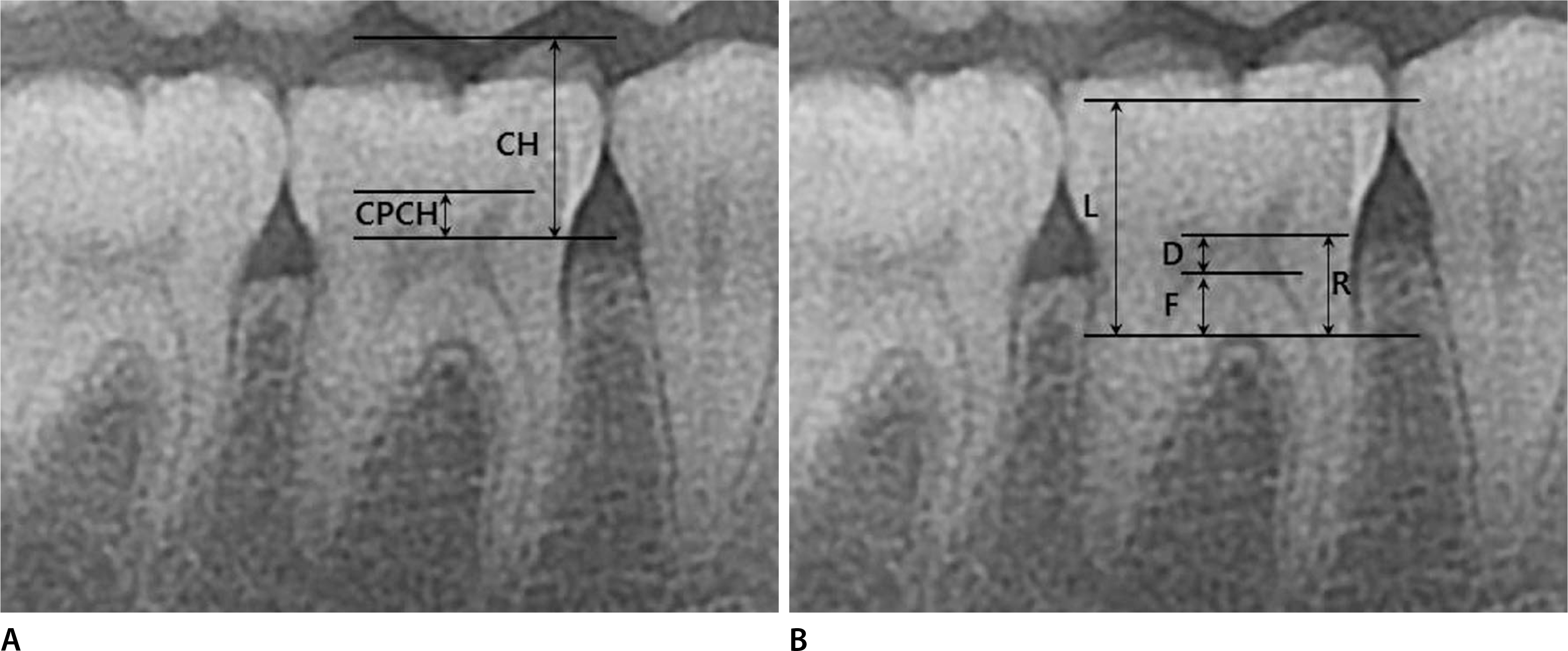Abstract
Age estimation is important in the practice of forensic science to establish the identity of human remains, as well as with living persons. Particularly in Korea, age estimation in adults has been increase in the demand for incorrect birth records in order to be entitled to civil liability, social benefits, employment. The reduction of pulp cavity size as a result of secondary dentin deposit with increasing age could be used to estimate age. This regressive change can be analyzed using radiological techniques; thus, a variety of methods for dental age estimation based on this approach have been proposed. The purpose of this study is to evaluate the concurrence between the Drusini's method and the Jeon's method using the mandibular first molar on orthopantomographs (OPGs) in Korean adults. A total of 232 OPGs (91 females and 141 males) of Korean individuals with ages ranging from 20 to 69 years were analyzed using Drusini's method and Jeon's method. Our results revealed that the correlation of the two methods with age was statistically significant (r=0.501). Both Drusini's method and Jeon's method showed significant correlation with chronological age, and Jeon's method showed a greater correlation with chronological age (r=0.738) than Drusini's method (r=0.586). The mean absolute error was 7.99 years for Jeon's method and 9.79 years for Drusini's method. Our results demonstrate that Jeon's method using the mandibular first molar on OPGs is a practical and suitable method for age estimation in Korean adults.
Go to : 
REFERENCES
1.Stavrianos C., Mastagas D., Stavrianou I, et al. Dental age estimation of adults: a review of methods and principals. Res J Med Sci. 2008. 2:258–68.
2.Morse DR. Age-related changes of the dental pulp complex and their relationship to systemic aging. Oral Surg Oral Med Oral Pathol. 1991. 72:721–45.

3.Ikeda N., Umetsu K., Kashimura S, et al. Estimation of age from teeth with their soft X-ray findings. Nihon Hoigaku Zasshi. 1985. 39:244–50.
4.Drusini AG., Toso O., Ranzato C. The coronal pulp cavity index: a biomarker for age determination in human adults. Am J Phys Anthropol. 1997. 103:353–63.

5.Jeon HM., Kim JH., Heo JY, et al. Age estimation by radiological measuring pulp chamber of mandibular first molar in Korean adults. J Oral Med Pain. 2015. 40:146–54.

6.Kvaal SI., Kolltveit KM., Thomsen IO, et al. Age estimation of adults from dental radiographs. Forensic Sci Int. 1995. 74:175–85.

7.Cameriere R., Ferrante L., Cingolani M. Variations in pulp/tooth area ratio as an indicator of age: a preliminary study. J Forensic Sci. 2004. 49:317–9.

8.Bosmans N., Ann P., Aly M, et al. The application of Kvaal's dental age calculation technique on panoramic dental radiographs. Forensic Sci Int. 2005. 153:208–12.

9.Landa MI., Garamendi PM., Botella MC, et al. Application of the method of Kvaal et al. to digital orthopantomograms. Int J Legal Med. 2009. 123:123–8.

10.Kanchan-Talreja P., Acharya AB., Naikmasur VG. An assessment of the versatility of Kvaal's method of adult dental age estimation in Indians. Arch Oral Biol. 2012. 57:277–84.

11.Karkhanis S., Mack P., Franklin D. Age estimation standards for a Western Australian population using the dental age estimation technique developed by Kvaal et al. Forensic Sci Int. 2014. 235:104. .e1-6.

12.Talabani RM., Baban MT., Mahmood MA. Age estimation using lower permanent first molars on a panoramic radiograph: a digital image analysis. J Forensic Dent Sci. 2015. 7:158–62.

13.Rajpal PS., Krishnamurthy V., Pagare SS, et al. Age estimation using intraoral periapical radiographs. J Forensic Dent Sci. 2016. 8:56–7.

14.Erbudak HO., Ozbek M., Uysal S, et al. Application of Kvaal et al.'s age estimation method to panoramic radiographs from Turkish individuals. Forensic Sci Int. 2012. 219:141–6.

15.Mathew DG., Rajesh S., Koshi E, et al. Adult forensic age estimation using mandibular first molar radiographs: a novel technique. J Forensic Dent Sci. 2013. 5:56–9.

17.Philippas GG., Applebaum E. Age factor in secondary dentin formation. J Dent Res. 1966. 45:778–89.

18.Willems G. A review of the most commonly used dental age estimation techniques. J Forensic Odontostomatol. 2001. 19:9–17.
19.Jeon HS., Tea IH., Ko MY, et al. Age estimation by dental radiographs in Korean adults. Korean J Oral Med. 2009. 34:179–88.
Go to : 
 | Fig. 1.Measurements performed on radiograph of a mandibular first molar by using Adobe Photoshop CS5 program. (A) Tooth measurements according to Drusini et al. [4]. CH, coronal height; CPCH, coronal pulp cavity height. (B) Tooth measurements according to Jeon et al. [5]. L, distance from the start point of lingual groove to the highest point on the root furcation; D, depth of the pulp chamber; F, distance between the floor of the pulp chamber and the highest point on the root furcation; R, distance between the roof of the pulp chamber and the highest point on the root furcation. |
Table 1.
Distribution of subjects in study according to age and gender
| Age group (yr) | Male | Female | Total |
|---|---|---|---|
| 20-29 | 26 | 21 | 47 |
| 30-39 | 29 | 17 | 46 |
| 40-49 | 25 | 17 | 42 |
| 50-59 | 31 | 19 | 50 |
| 60-69 | 30 | 17 | 47 |
| Total | 141 | 91 | 232 |
Table 2.
Pearson's correlation coefficients (r) between Drusini's and Jeon's method for the pooled sample, and each sex
| Sex | Correlation coefficients (r) |
|---|---|
| Male (n=141) | 0.481∗ |
| Female (n=91) | 0.528∗ |
| Pooled sample (n=232) | 0.501∗ |
Table 3.
Pearson's correlation coefficients (r) between Drusini's method, Jeon's method and chronological age for age group
| Method | Correlation coefficients (r) |
|---|---|
| Drusini's method | 0.586∗ |
| Jeon's method | 0.738∗ |
Table 4.
MAE and percentage of estimated ages <±MAE years and <±10 years for age group




 PDF
PDF ePub
ePub Citation
Citation Print
Print


 XML Download
XML Download